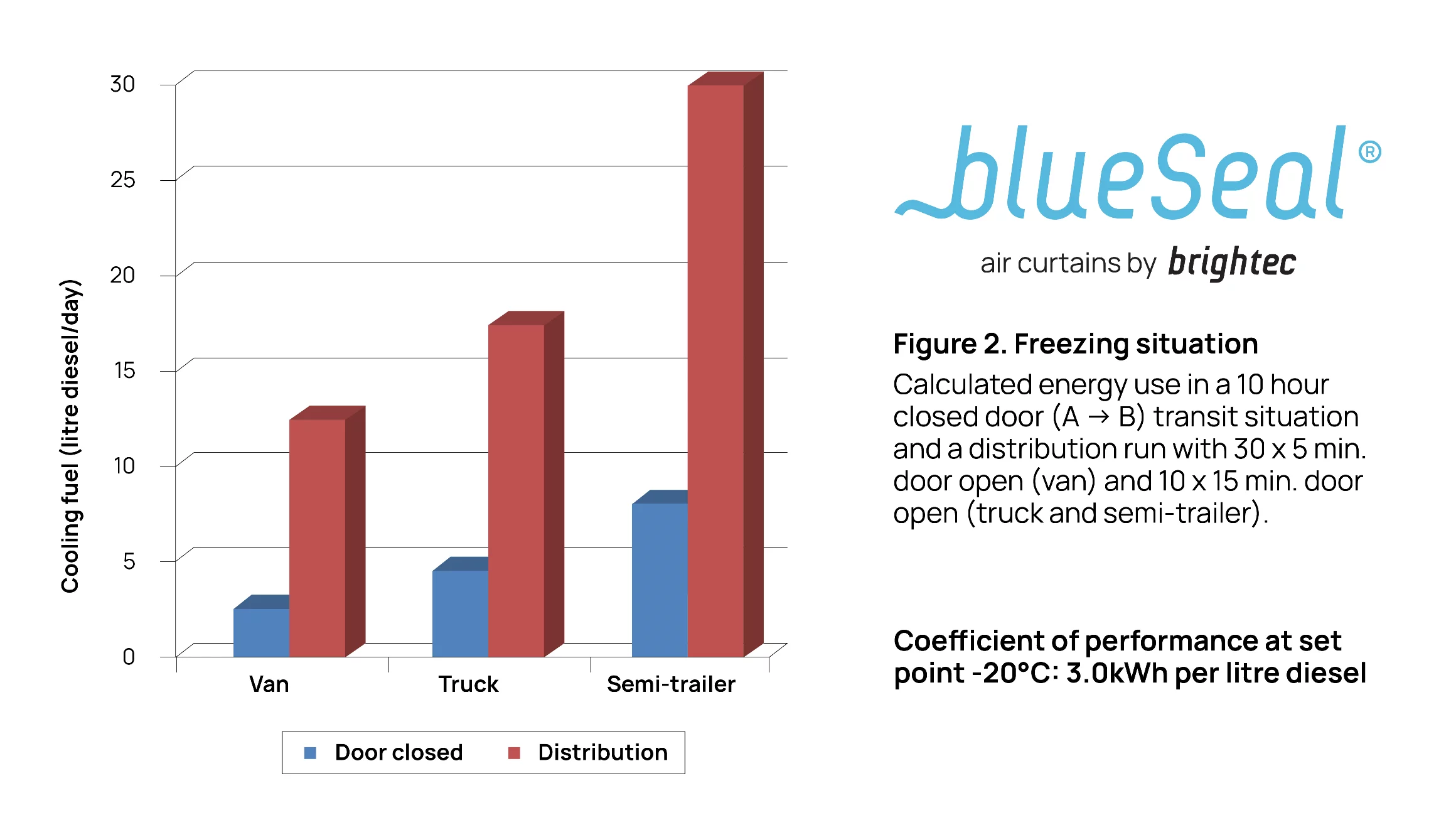
BlueSeal – Optimale Klimakontrolle für den Kühltransport: Diesel sparen und die Kühlkette sichern
Hinweis: Dieser Artikel wurde maschinell übersetzt und kann geringfügige Abweichungen enthalten. Für die ursprüngliche (englische) Version dieses Artikels ändern Sie bitte die Spracheinstellung auf der Website.
Temperaturgeführte Produkte wie Lebensmittel und Pharmazeutika sind während des Transports auf stabile Innenraum-Bedingungen angewiesen. Doch bei der Auslieferung mit mehreren Stopps führt jede Türöffnung zu einem schnellen Verlust gekühlter Luft, wodurch Kühlaggregate stärker arbeiten und mehr Kraftstoff verbrauchen müssen. Die bestmögliche Klimakontrolle für den Kühltransport ist daher entscheidend, damit Energieverschwendung vermieden und die Produktintegrität bewahrt werden kann.
Warum die bestmögliche Klimakontrolle für den Kühltransport entscheidend ist
In Städten und auf dem Land setzen viele Transportunternehmen bereits auf eine Klimabarriere an den Fahrzeugtüren, um Kälteverluste zu minimieren. Traditionell waren PVC-Streifenvorhänge die Standardlösung, doch immer mehr Betreiber setzen auf Luftschleier als optimale Klimakontrolle für den Kühltransport.
Ohne Klimabarriere müssen Kühlaggregate bei Stop-and-Go-Routen deutlich mehr leisten. Das führt zu erhöhtem Dieselverbrauch, mehr Wartungsaufwand und höherer Umweltbelastung.
Studienziel: Quantifizierung der Auswirkungen fehlender Klimaschutzmaßnahmen
Mit dem Brightec-Simulationsmodell von 2019 haben wir den täglichen Energieverbrauch für Fahrzeuge mit Sollwerten von 4 °C (gekühlt) und -20 °C (tiefgefroren) bei einer Außentemperatur von 28 °C gemessen – für drei gängige Fahrzeugtypen: Transporter, Lkw und Sattelauflieger.
Die beste Klimakontrolle für den Kühltransport wurde mit dem Szenario ohne Klimabarriere verglichen, um den Einfluss auf den Kraftstoffverbrauch zu ermitteln. Die Leistungskoeffizienten basieren auf realen Kühlaggregat-Testergebnissen: 4,0 kWh/L für Kühltransporte und 3,0 kWh/L für Tiefkühltransporte.

Ergebnisse ohne die optimale Klimakontrolle für den Kühltransport
Selbst während der Fahrt mit geschlossenen Türen ist aktive Kühlung notwendig, um Kälteverluste durch Wände, Boden, Decke und Türen auszugleichen. Der Grundbedarf beträgt:
- Gekühlt (4 °C): 4, 8 und 14 kWh/Tag (1, 2 und 3,5 Liter Diesel) für Transporter, Lkw und Auflieger.
- Tiefgekühlt (-20 °C): 2,5, 4,5 und 8 Liter Diesel/Tag für Transporter, Lkw und Auflieger.
Ohne Klimabarriere während der Verteilfahrten:
- Gekühlt (4 °C): 20, 32 und 50 kWh/Tag (5, 8 und 12,5 Liter Diesel).
- Tiefgekühlt (-20 °C): 12,5, 17,5 und 30 Liter Diesel/Tag.
Türöffnungen steigern den Kühlbedarf um das 3- bis 5,5-Fache, also 200-450 % mehr Energie. Bei einem Sattelauflieger entspricht dies bis zu 9 Litern zusätzlichem Diesel pro Tag (gekühlt) und 22,5 Litern pro Tag (tiefgekühlt).
Jährliche Mehrkosten ohne die beste Klimakontrolle für den Kühltransport
Auf Basis von 250 Betriebstagen pro Jahr und einer durchschnittlichen Außentemperatur von 16 °C:
- Gekühlt: + 500 L (Transporter), + 750 L (Lkw), + 1.125 L (Sattelauflieger) Diesel/Jahr.
- Tiefgekühlt: + 1.850 L (Transporter), + 2.380 L (Lkw), + 4.600 L (Sattelauflieger) Diesel/Jahr.
Diese Werte beinhalten nicht die zusätzlichen Wartungskosten durch die höhere Belastung der Kühlaggregate.
Warum Luftschleier die beste Klimakontrolle für den Kühltransport sind
BlueSeal-Luftschleier bilden eine unsichtbare Barriere, die den Temperaturverlust bei Türöffnungen reduziert, ohne die Bewegungsfreiheit des Fahrers einzuschränken. Im Gegensatz zu PVC-Streifen verbessern sie die Hygiene und erfordern keinen physischen Kontakt.
Hauptvorteile:
- Reduziert den Dieselverbrauch um mehrere tausend Liter pro Jahr.
- Hält die Produkttemperatur während des gesamten Lieferwegs konstant.
- Verringert den Verschleiß der Kühlanlagen.


Fazit: Die optimale Klimakontrolle für den Kühltransport spart Geld
Türöffnungen können den Kraftstoffverbrauch um mehrere tausend Liter pro Jahr erhöhen. Die Implementierung der bestmöglichen Klimakontrolle für den Kühltransport, wie BlueSeal-Luftschleier, senkt die Dieselkosten, reduziert die Umweltbelastung und schützt zuverlässig die Kühlkette.
Künftige Untersuchungen werden das volle Einsparpotenzial dieser Lösung in verschiedenen Klimazonen und Liefer-Profilen beleuchten.
Für weitere Informationen zu BlueSeal-Luftschleiern kontaktieren Sie bitte unsere Brightec-Berater unter [email protected]